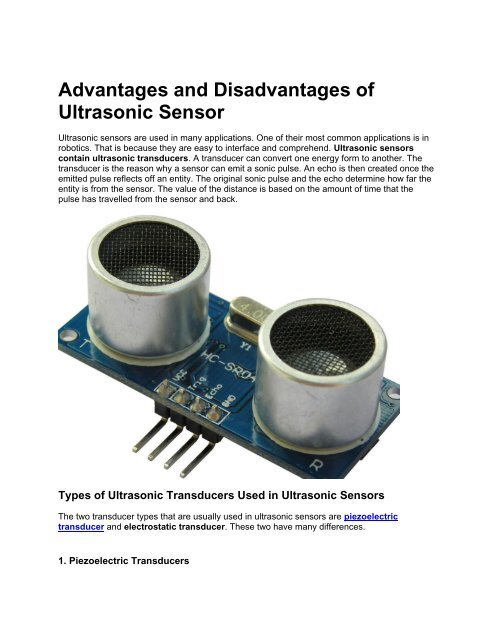Why ultrasonic sensor is better than other sensors
1. Reliable detection: Ultrasonic sensors work using sound waves, allowing them to detect obstacles without being affected by various factors.
2. Cost-effective: If you are willing to compromise reliability for cost, infrared sensors can be a suitable option.
Disadvantages of ultrasonic sensors
1. Expensive: Ultrasonic sensors tend to be more expensive compared to other sensor types.
2. Limited use on thin materials: They can be challenging to use on thin materials.
3. Complications with part geometry: The geometry of the part being tested can cause complications.
4. Requires smooth surfaces: Ultrasonic sensors need a relatively smooth surface to couple the transducer.
What is the purpose of ultrasonic sensor
An ultrasonic sensor is used to measure the distance to a target by emitting sound waves and measuring the time it takes for the waves to bounce back. Unlike optical sensors that use separate transmitters and receivers, ultrasonic sensors use a single ultrasonic element for both emission and reception.
Three disadvantages of using ultrasonic sensors
1. Limited testing distance: Ultrasonic sensors have a maximum range for accurate measurement.
2. Inaccurate readings: The readings from ultrasonic sensors may not always be precise.
3. Inflexible scanning methods: Some ultrasonic sensors have limitations in terms of scanning methods.
How reliable is an ultrasonic sensor
The reliability of an ultrasonic sensor can vary depending on the specific model and application. However, generally speaking, ultrasonic water level sensors, for example, can provide accurate readings with an accuracy of ±0.144 inches for a full-scale range of 12 feet (at ambient temperature and controlled conditions).
How far can an ultrasonic sensor detect
Ultrasonic sensors have a limited range and can typically detect objects within a distance of up to 70 feet (21 meters). However, the accuracy and reliability of the measurements may decrease as the distance increases. The maximum rate at which they can measure is 200 Hz at a maximum distance of approximately 24 inches. Additionally, ultrasonic sensors may not work as effectively in vapor environments that alter the speed of sound compared to air.
What materials can an ultrasonic sensor detect
Ultrasonic sensors can detect objects made from various materials, including wood, metal, or plastic. The shape and color of the objects do not affect the detection ability. The objects can be in solid, liquid, or powdered form, as long as they can reflect sound waves back to the sensor.
How accurate are ultrasonic sensors
Ultrasonic sensors can provide an accuracy of up to 1% of the set measuring range. The actual accuracy may vary depending on the specific sensor model and environmental conditions.

Why ultrasonic sensor is better than other sensors
Ultrasonic sensors work using sound waves, detecting obstacles is not affected by as many factors. If reliability is an important factor in your sensor selection, ultrasonic sensors are more reliable than IR sensors. If you're willing to compromise reliability for cost, infrared sensors are ideal for your application.
What is the disadvantage of ultrasonic
Disadvantages of Ultrasonic Testing Techniques:
More expensive than other methods. Difficult to use on thin materials. Part Geometry can cause complications. Needs relatively smooth surface to couple transducer.
Cached
What is the purpose of ultrasonic sensor
ultrasonic / level sensors measure the distance to the target by measuring the time between the emission and reception. An optical sensor has a transmitter and receiver, whereas an ultrasonic / level sensor uses a single ultrasonic element for both emission and reception.
What are 3 disadvantages of using ultrasonic sensors
Some common disadvantages of conventional ultrasonic sensors include limited testing distance, inaccurate readings, and inflexible scanning methods.
How reliable is ultrasonic sensor
For example, an ultrasonic water level sensor reading a full-scale range of 12 feet or 144 inches will have an accuracy of ±0.144 inches (at ambient temperature and controlled conditions). The same sensor reading a distance of 75 inches will have an accuracy of ±0.075 inches.
How far can ultrasonic sensor detect
They DO NOT measure farther than about 70 feet (21 meters). They DO NOT measure at very high repetition rates. Due to speed of sound limitations the fastest rate is 200 Hz at a max distance of about 24 inches. They DO NOT work as accurately in vapor environments that change the speed of sound from that of air.
What materials can an ultrasonic sensor detect
Pepperl+Fuchs' ultrasonic sensors detect objects made from materials such as wood, metal, or plastic regardless of their shape or color. These objects can be solid, liquid, or in powdered form. The only requirement is that they are able to reflect sound waves back to the sensor.
How accurate are ultrasonic sensors
With an ultrasonic sensor, an accuracy of up to 1% of the set measuring range can be achieved. This means that an object can be detected with an accuracy of 1 mm at a distance of 10 cm. In order for an ultrasonic sensor to work reliably, the sound is emitted at a fixed frequency.
What can ultrasonic sensor not detect
For presence detection, ultrasonic sensors detect objects regardless of the color, surface, or material (unless the material is very soft like wool, as it would absorb sound.) To detect transparent and other items where optical technologies may fail, ultrasonic sensors are a reliable choice.
Can ultrasonic sensor detect cars
Ultrasonic sensors can be used to complement other vehicle sensors, including radar, cameras, and lidar, to get a full picture of the immediate surroundings of a vehicle.